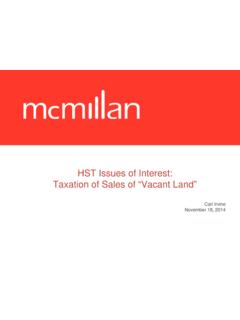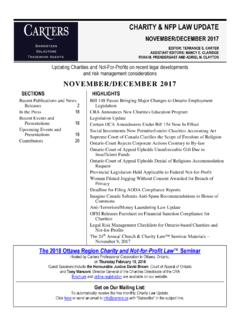Transcription of Employment Law in Canada - mcmillan.ca
1 Employment law in Canada :federally regulated employersfederal and provincial jurisdictionIn Canada , the power to make laws is divided between the federal and provincial the area of Employment law, the federal government has jurisdiction over Employment laws for specific works and undertakings within exclusive federal constitutional jurisdiction, such as shipping, railways, broadcasting, airlines and banks. Many Employment relationships, however, do not come within exclusive federal jurisdiction and are governed by the law of the province in which they are located. Only the federal laws will be addressed in this standards of employmentThe Canada Labour Code (the Code ) sets out the minimum standards that govern the basic terms and conditions of Employment for federal workers, including minimum wage levels, vacation and holiday pay, hours of work, maternity leave, notice periods for termination, and severance payments.
2 Employers and employees are not permitted to contract out of these minimum of the minimum standards for federal workers at the time of writing are set out below: minimum wage Federal workers must be paid (at least) the minimum hourly wage rate set by the province in which the employee is usually employed. In Ontario the minimum wage rate for most adult workers is $ per of work 8 hours per day 40 hours per week Overtime paid at times regular wagepublic holiday 9 holidays (New Year s Day, Good Friday, Victoria Day, Canada Day, Labour Day, Thanksgiving Day, Remembrance Day, Christmas Day, Boxing Day)paid vacation Two weeks after 12 months of Employment for those employed for less than 6 consecutive years; three weeks after 6 consecutive years of Employment 4% of wages as vacation pay for those employed less than 6 consecutive years; 6% of wages as vacation pay after 6 consecutive years of employmentpregnancy leave 17 week job-protected leave without payparental/adoptive leave 37 week job-protected leave without pay.
3 37 week aggregate leave for two employees in relation to the same birth or adoptionemployment law in Canada - federally regulated employersMcMillan LLP | care leave 8 weeks job-protected leave without pay so an employee can care for or support a family member if a qualified medical practitioner issues a certificate stating that there is a serious medical condition with a significant risk of death within 26 weekstermination of employmentTermination of Employment is one of the most significant areas of Employment law. Usually, the analysis of a termination begins with an examination of whether there is cause for the termination, followed by an assessment of the employer s obligations in connection with the for causeThere is no Employment at will in Canada .
4 An employer is generally only entitled to dismiss an employee from Employment without notice where it has cause in law to do is no end to the various types or degrees of conduct or misconduct that can constitute cause for the termination of an employee s Employment . However, cause may be thought of as existing on a spectrum, with single incidents of serious employee misconduct at the high end of the spectrum, and minor but repeated incidents of unsatisfactory conduct at the low all but the most serious of misconduct cases, a single incident of employee misconduct usually does not constitute cause for termination of the Employment . Single incidents of serious misconduct that constitute cause do occur from time-to-time. For example, employees are sometimes caught stealing or misappropriating significant assets or resources from their employer.
5 In such cases, where strong evidence of the theft or misappropriation is obtained, cause for the termination of the employee s Employment may exist. However, such cases are relatively , cause or potential cause cases arise in the context of much less serious conduct, such as attitude, attendance or job performance problems. Cause may exist in these cases, but usually only if the employee has continuously failed to meet the employer s reasonable, expressed expectations, despite repeated warnings to the contrary. In that regard, the Courts (and other authorities of this jurisdiction) generally require the employer to provide a series of clear, written warnings to the employee regarding the employee s unsatisfactory conduct and the need to improve or correct that conduct, before terminating the Employment relationship for cause.
6 The employee should be notified that the Employment relationship is in jeopardy as a result of the maligned conduct, and should be given a reasonable opportunity to improve or correct the conduct before being dismissed for should be clear from the foregoing, termination of Employment for cause is considered exceptional , and a substantial burden is placed on an employer to establish that it has cause to end the Employment relationship without should note that under the Code non-unionized employees have recourse to an unjust dismissal provision. The right to file a complaint under the Code is in addition to the right to commence an action for wrongful dismissal. The provision provides that an employee who has completed twelve (12) consecutive months of continuous Employment may file a complaint if the employee considers the dismissal to be unjust : that is, without cause.
7 The complaint will be referred to an adjudicator for hearing to determine whether the employee s dismissal was unjust, notwithstanding any termination payments in lieu of notice offered by the employer, or alternatively whether the dismissal is exempt from the unjust dismissal provision for other reasons. These exemptions include where the employee has been laid off because of lack of work or because of the discontinuance of a function . If so, the adjudicator will McMillan LLP | law in Canada - federally regulated employersnot hear the complaint on its merits. However, in order to demonstrate that an exemption applies, the employer will be required to provide evidence as to why a particular employee was dismissed for lack of work or because of the discontinuance of a function as opposed to another a complaint of unjust dismissal is upheld, the employee may be awarded reinstatement as well as additional compensation.
8 Under the Code, an unjust dismissal complaint does not apply to an employee who is a manager . However, the threshold established under the decided cases as to who is a manager so as to be disentitled from accessing this Code provision is extremely without causeIn the absence of cause for dismissal, employers must generally provide employees with working notice of termination of Employment or pay in lieu of notice. A federal employee s entitlements on termination without cause arise from three potential sources: i. minimum standards established by the Code; ii. the right to reasonable notice of termination at common law; and iii. termination provisions in an enforceable, written Employment of these is briefly discussed Canada Labour Code: Notice and Severance PayThe Code sets out minimum standards for two types of potential termination entitlements: notice of termination and severance pay.
9 These obligations may be avoided where there is cause for the dismissal of an employee, although the Code does not define what constitutes just cause for dismissal. Determinations of whether there is cause for dismissal will be made on a case-by-case basis, based on common law principles. In the absence of such cause, notice and severance pay obligations must be considered, and each of these is discussed notice of termination The Code provides minimum standards for individual notice of termination obligations and, where 50 or more employees are terminated from an establishment within a four-week period, mass termination employer can comply with the notice requirements under the Code by providing working notice, termination pay in lieu of notice or a combination of both.
10 During the statutory notice period, the employer must maintain group health and welfare benefits whether or not the employer chooses to dismiss the employee noticeIndividuals employed less than three consecutive months are not entitled to notice. All employees who have completed three consecutive months of continuous Employment or more are entitled to two weeks of law in Canada - federally regulated employers5mass terminationsAdditional requirements must be complied with in the case of a mass termination, which is the termination of 50 or more employees at the employer s establishment within a four-week period. In addition to providing notice to the individual employees affected, as prescribed above, an employer undertaking a mass termination must comply with certain statutory obligations including the provision of written notice to the Minister of Labour.










